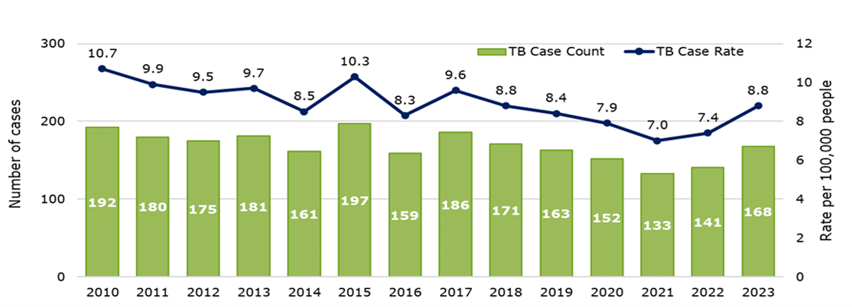Tuberculosis (TB) information for health care providers
Last content update: 3/25/24
The TB Prevention and Control Program investigates all reports of persons with confirmed or suspected TB disease in Santa Clara County. We provide individualized case management to each patient to help ensure treatment completion and to prevent TB from spreading further. We also provide consultation to medical providers and community partners.
TB disease
TB is a disease caused by a bacteria that is spread through the air from person to person. Although TB most often affects the lungs, it can affect any part of the body including lymph nodes, bones, kidneys, and the brain. TB can cause very severe illness and it can be fatal. Fortunately, TB can be prevented, treated, and cured.
Symptoms
Symptoms of TB can include fever, weight loss, night sweats, and fatigue. When TB affects the lungs, symptoms can also include a cough that lasts more than 2 to 3 weeks, coughing up blood, and chest pain. If you have any of these symptoms you need to see a doctor.
Populations at risk
TB can infect anyone who lives, works, or breathes in close proximity to someone with infectious TB disease, regardless of their age, race, sex, or socioeconomic status. Over 90 percent of patients with TB disease in SCC were born outside of the U.S., though most have lived in the U.S. for more than 5 years. In Santa Clara County, the majority of cases occur among people born in Vietnam, the Philippines, India and China.
For more information on TB, download the 2023 Tuberculosis Fact Sheet.
Screening
The California Department of Public Health, US Preventive Services Task Force (USPSTF) and the American Academy of Pediatrics recommend serially screening people for risk of TB infection or disease. TB testing should only be performed for those who were born in or lived in countries with increased TB disease prevalence, who were exposed to an individual with TB disease, who have comorbidities which put them at risk for progression to TB disease and persons who have lived in high risk congregate settings (homeless shelter or correctional facilities) in the U.S. See links to Risk Assessment tools below.
TB data in Santa Clara County
Figure 1. TB case counts and rates, 2010-2023
This figure shows the TB case counts and rates in Santa Clara County from 2010 to 2023. In 2023, there were 168 cases reported with a rate of 8.8 cases per 100,000 people. This was a 19% increase from 2022.
This figure shows the case rate of TB per 100,000 people for 2023 for those born in the Philippines, Vietnam, India, Mexico, China, and the United States. Case rate is highest in those born in the Philippines, with a rate of 65 cases per 100,000 people.
This figure shows the percentage of TB cases in different age groups in 2023. 73% of cases were 45 years of age or older and 48% cases were 65 years of age and older.
Other characteristics of TB cases in 2023
- 36% had at least one comorbidity (similar to 2022)
- 26% had diabetes mellitus, the most common comorbidity (similar to 2022)
- 15% displayed resistance to any of the four first-line drugs (decreased from 17% in 2022)
For more local data, download the 2023 Tuberculosis Infographic.
Provider tools
Short-course regimens (Rifampin daily for 4 months, INH and Rifampin daily for three months and once weekly INH and rifapentine) have similar efficacy and higher treatment completion rates as compared with 9 months of daily isoniazid and are recommended for most patients who need treatment for latent TB infection (LTBI).
Treatment regimens for LTBI
1. 12- dose Weekly Isoniazid/Rifapentine Regimen (3HP) (3HP CDPH Fact Sheet)
- Isoniazid 2-11 years old: 25 mg/kg rounded up to nearest 50 or 100 mg (max. 900 mg) ≥ 12 years old: 15 mg/kg rounded up to nearest 50 or 100 mg (max. 900 mg)
- Rifapentine 10.0-14.0 kg: 300 mg 14.1-25.0 kg: 450 mg 25.1-32.0 kg: 600 mg 32.1-50.0 kg: 750 mg >50 kg: 900 mg
- Vitamin B6 50 mg weekly
This regimen is not recommended for pregnant women, children under 2 years-old, HIV-positive patients on antiretroviral medications, or those exposed to a person with INH or RIF-resistant TB.
2. Rifampin- Daily for 4 months. (Rifampin CDPH Fact Sheet)
Adults: 600 mg; Children: 15 - 20 mg/kg (max. 600 mg)
3. Isoniazid 10 mg/kg - Daily for 9 months. (Isoniazid CDPH Fact Sheet)
(range, 10-15 mg/kg; max. 300 mg) Recommended pyridoxine dosage is 25 mg for school-aged children (or 1-2 mg/kg/day)
4. Isoniazid and Rifampin - Daily for 3 months. (CDC Fact Sheet)
Children: Isoniazid 10-20 mg/kg (300 mg maximum) Rifampin 15- 20 mg/kg; (600 mg maximum)
For patients treated with an isoniazid-containing regimen, daily vitamin B6 (pyridoxine) supplementation (25 mg) recommended for patients with other conditions associated with neuropathy (diabetes, HIV, chronic renal failure, alcoholism) or who are pregnant or breastfeeding. For children receiving vitamin B6, the recommended dosage is 6.25 mg for infants, 12.5 mg for toddlers, and 25 mg for school-aged children (or 1-2 mg/kg/day).
For more information, please see the CDPH/CTCA Latent Tuberculosis Infection Guidance for Preventing Tuberculosis in California.
School mandate information
The County of Santa Clara Public Health Department Risk Assessment for School Entry form is required for school registration effective June 1, 2014, for all children enrolling in kindergarten or transferring, at any grade level, from outside of Santa Clara County.
For more information, please see the School Mandate Packet for Health Care Providers and Schools. This replaces the need to perform TB testing in all children.
TB screening requirements for children in child care
Please see Tuberculosis Screening for Children in Childcare fact sheet for more information.
TB screening requirements for child care/school staff and volunteers
The California Department of Public Health (CDPH) Tuberculosis Risk Assessment for Child Care/School Staff and Volunteers satisfies California Education Code, Sections 49406 and 87408.6 and the California Health and Safety Code, Sections 1597.055 and 121525, 121545, and 121555.
Other risk assessments
The US Preventive Services Task Force (USPSTF) recommends screening persons at increased risk for LTBI, including those who were born in or lived in countries with increased TB disease prevalence and persons who have lived in high-risk congregate settings (for example, homeless shelters or correctional facilities) in the U.S.
- California Tuberculosis Adult Risk Assessment and User Guide (PDF)
- California Tuberculosis College and University Students Risk Assessment User Guide (PDF)
- California Tuberculosis Pediatric Risk Assessment and User Guide (PDF)
For routine well-child checks, the pediatric TB risk assessment should be used. However, this form does not meet the requirements for students newly enrolling in Santa Clara County schools.
Clinical consultation
During business hours, please call the TB Provider line at (408) 885-2440.
After business hours, please call the County of Santa Clara Public Health Department and ask for the Health Officer on-call at (408) 998-3438.
Resources
Tuberculosis (TB) Prevention and Control Program
Santa Clara County Public Health Department
976 Lenzen Ave., Suite 1700
San Jose, CA 95126
Phone: (408) 792-1381
Fax: (408) 885-2331




